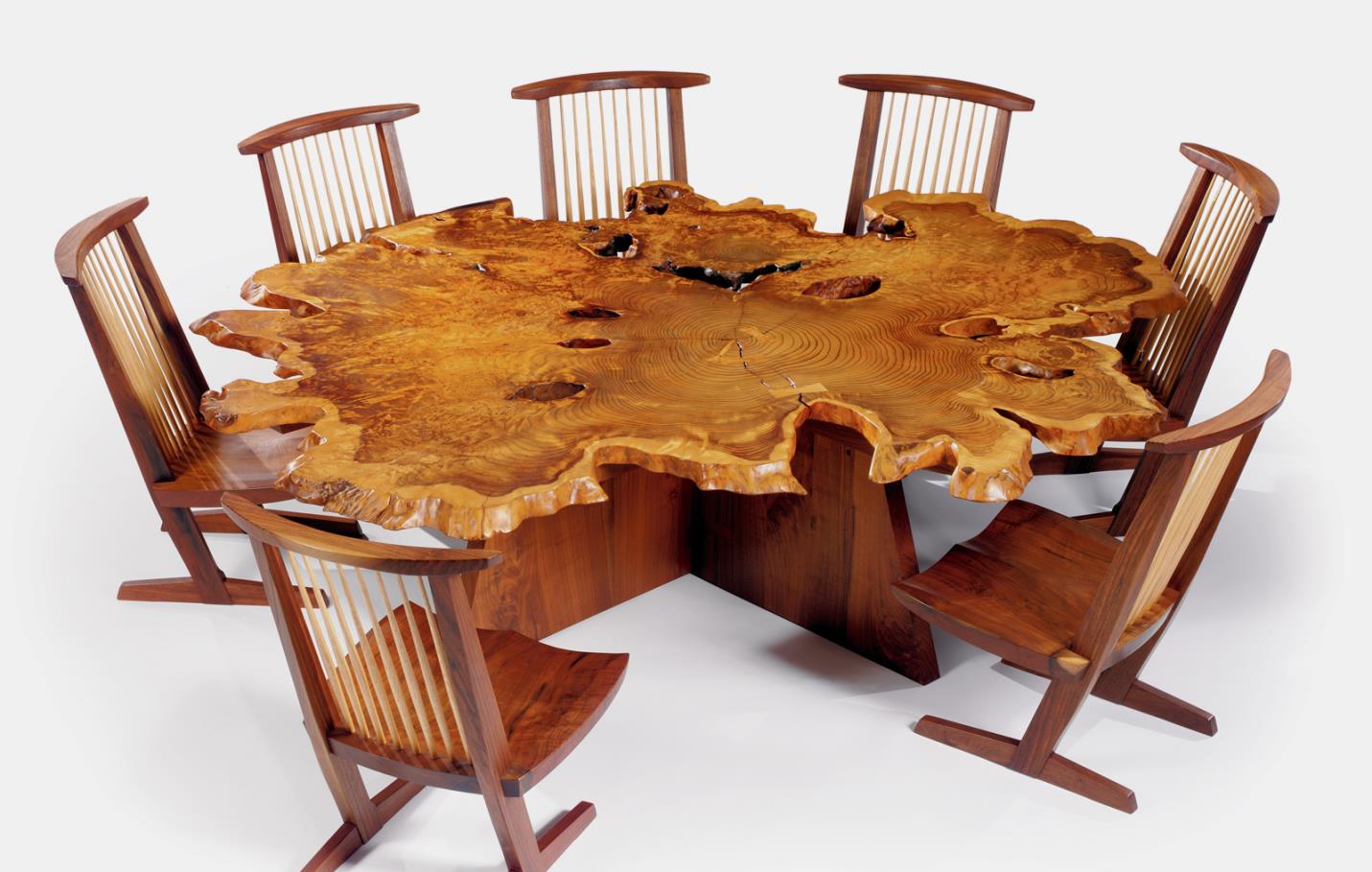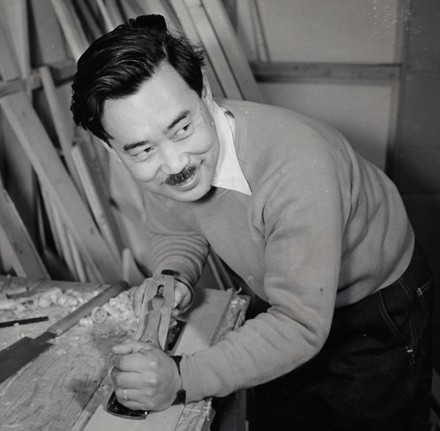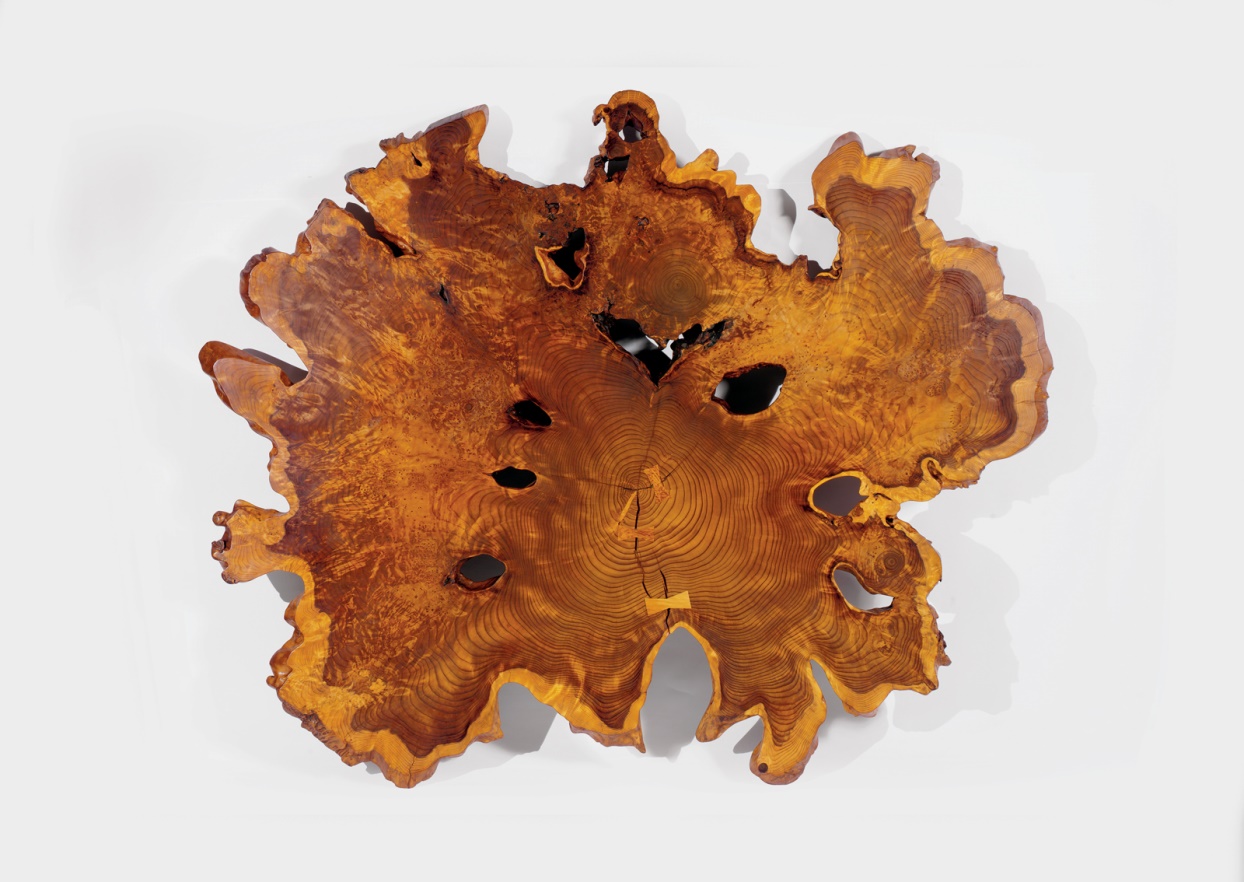Newsletter

George Nakashima's “Arlyn” table - redwood, black walnut, madrone burl, and east indian laurel; 26” x 89” x 91”. Conoid chairs - walnut and hickory; 35 ½” x 20” x 21”.
“The working of wood has brought me into another world. It reveals a kinship with nature and a search for its deepest relationship with man...Ultimately the woodworker’s responsibility is to the tree itself, which has been sacrificed to live again in the woodworker’s hands.”
-- George Nakashima
Visitors to the new Museum of the American Arts and Crafts Movement in St. Petersburg, Florida will soon be able to see the legendary “Arlyn” table, arguably the most important piece of furniture ever created by master craftsman and artist George Nakashima (1905-1990). The magnificent table has been in the collection of the Two Red Roses Foundation since it was purchased in 2006 at Sotheby’s New York sale of the famed Arthur and Evelyn Krosnick collection and will be on view, along with six Nakashima Conoid dining chairs, in an upstairs gallery when the Museum opens next year.
The Arlyn table has its own unique story. Nakashima created the piece in 1988 for his Princeton, New Jersey patrons, Dr. Arthur Krosnick and his wife Evelyn. “Arlyn” is an acronym formed from the couples’ first names. The nine-foot-wide table is made from a cross-section of burled redwood originally from the San Francisco Bay Area’s Muir Woods. The tabletop features ten holes, three butterfly joints, and an intricate ragged edge that sits atop two intersecting black walnut slabs. It is one of only two Nakashima pieces that escaped the horrific fire that destroyed the Krosnick home on May 23, 1989 taking with it more than 100 pieces of Nakashima’s work. A workman’s defective blowtorch had ignited a blaze in the basement that, within a few hours, burned the entire house and its contents to the ground.
Just three weeks prior, on May 8, a major retrospective exhibition entitled “George Nakashima: Full Circle” opened at the American Craft Museum (now the Museum of Arts and Design) in New York City. The Krosnicks had agreed to loan the Arlyn table, along with a Nakashima picture frame, to the Museum for the exhibition. These two pieces were the only “survivors” of the fire. The Krosnicks vowed to rebuild their beloved home, a project that would greatly depend on Nakashima. He was quoted in The New York Times, “It is a great loss — for them and for us. Some of the pieces can be replaced, but many cannot. They are precise pieces — one of a kind…” The day after the fire, on his 84th birthday, he said these words to Arthur and Evelyn Krosnick, “We do not know why this happened, but we will rebuild your lives.”
After the bombing of Pearl Harbor during World War II, along with other Americans of Japanese ancestry, the Nakashimas were interned at Camp Minidoka in Idaho. Living conditions were harsh, but it was there that he met Gentauro Hikogawa, a skilled woodworker who had been trained in traditional Japanese carpentry. Under his guidance, Nakashima learned to master traditional Japanese hand tools and joinery techniques. Woodworking became his calling from that time forward.
Ultimately, the Nakashimas were sponsored by his friend and former employer Antonin Raymond to move to his farm in New Hope, Pennsylvania. There in the Delaware Valley, Nakashima established his home, studio, and workshop. He died in 1990 at age 85, a little more than a year into the Krosnick rebuilding project. His daughter Mira, who had worked by his side since the 1970s, saw the project through to the end. Today, she continues to lead the Nakashima studio, creating works under her own name while carrying forth the methods and techniques embraced by her father.
One might wonder what a 1989 table is doing in a museum featuring objects from the American Arts and Crafts Movement. After all, Nakashima was still a child when the Movement began to fade, making way for a new age of rapid industrialization and the streamlined glamour of Art Deco. Nevertheless, his creations from the last half of the 20th century are often reflective of the same aesthetic values of Arts and Crafts practitioners such as Frank Lloyd Wright, Gustav Stickley, Greene and Greene and others. Nakashima valued tradition and simplicity in design along with a deep respect for the materials he worked with. His furniture pieces were made by hand, one at a time, without extra color, frills, or embellishment. While he favored minimal technology, he accepted the machine as an aid to craftsmanship. Similar to Wright and the Greene brothers, he described himself as “an architect for complete environments, able to produce an integrated concept of architecture, furnishings and landscaping.”
In the 1989 exhibition catalogue for the American Craft Museum retrospective of his work, Nakashima wrote: “The fight for beauty has occupied my lifetime, and I have sought to create beauty in a world where little of it seems to exist. My efforts are small points of light within a larger light that is still possible and can grow to a great illumination.” George Nakashima’s Arlyn table is indeed a creation of eloquence and incomparable beauty. The Museum of the American Arts and Crafts Movement will be proud to share it with its visitors.

